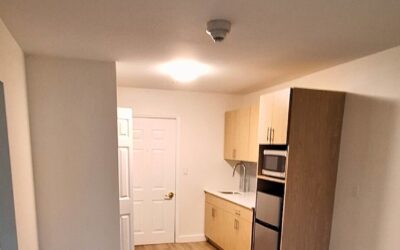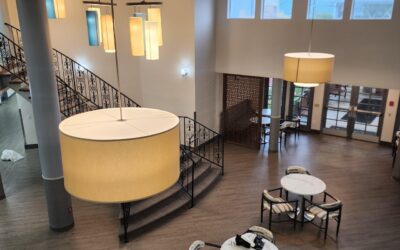In a world where efficiency and innovation are paramount, the construction industry continuously evolves to meet growing demands. That’s where design build construction or build design construction comes in. Recent projections estimate nearly half of construction spending will be allocated to the design-build model in the coming years, illustrating its rapid acceptance and the benefits it brings to project delivery and stakeholder collaboration.
From the wonders of ancient architecture to modern skyscrapers reaching for the sky, construction has transformed significantly over the centuries. Today, we find ourselves at the crossroads of traditional methods and cutting-edge design-build approaches that promise not only streamlined projects but also enhanced accountability and creativity.
This blog post explores the multifaceted world of design-build construction, offering insights into its advantages, applications, and future in the industry.

The Evolution of Construction from Ancient Times to Modern Techniques
Humans have been building since time immemorial. From the pyramids of Egypt to the Parthenon in Greece, ancient builders employed ingenious methods and rudimentary tools to create structures that continue to awe and inspire.
These monumental feats were achieved through sheer manpower and primitive machinery, laying the foundation for construction techniques that would evolve over millennia.
During the Middle Ages, construction became more organized, with guilds playing a pivotal role in shaping architectural styles and practices. The need for fortified castles and grand cathedrals led to advancements in design and material use, setting the stage for the subsequent industrial revolution.
The Industrial Revolution marked a turning point in construction, introducing machinery, new building materials, and standardized processes. Innovations like steam-powered tools and steel beams revolutionized how structures were designed and built. The transition from manual labor to mechanized construction paved the way for modern techniques that prioritize efficiency, safety, and sustainability.

What is Design-Build Construction?
Definition and Explanation of Design-Build Construction
Design-build construction is a project delivery method that revolutionizes the traditional construction process by merging the design and construction phases into a single, cohesive contract. This approach designates a single entity, known as the design-builder, to oversee all aspects of the project, from initial architectural design to final construction. By consolidating these phases, the design-builder becomes the sole point of contact for the project owner, streamlining communication and enhancing accountability.
In this method, the design-builder is tasked with delivering a completed project that aligns with the owner’s specifications and budgetary constraints. This unified approach eliminates the need for separate contracts for design and construction, significantly reducing the risk of miscommunication and errors. The design-builder collaborates closely with the owner to understand their vision and goals, crafting a design that meets their requirements while staying within budget.
Design-build construction is particularly advantageous for commercial construction projects, where efficiency and innovation are paramount. This method is ideal for complex projects that demand a high level of collaboration and creative problem-solving among designers, engineers, and contractors. By integrating the design and construction phases, design-build construction ensures a seamless and efficient project delivery, ultimately leading to superior outcomes.
The Construction Industry Today: Meeting Client Needs and Codes
Today’s construction industry is a dynamic field driven by technological advancements, regulatory standards, and client expectations. Modern construction methods focus on fulfilling client needs while adhering to strict codes and regulations, ensuring safety and quality are never compromised.
At the heart of this evolution lies the emphasis on integrating technology into every facet of the construction process. From Computer-Aided Design (CAD) software that enables precise architectural designs to Building Information Modeling (BIM) systems that facilitate project coordination, technology has become indispensable.
The design-build model streamlines communication and coordination throughout a construction project, ensuring faster completion and potentially reducing costs. Furthermore, sustainability has taken center stage in contemporary construction practices.
Developers now prioritize eco-friendly materials and energy-efficient designs to meet environmental standards and cater to an increasingly conscious clientele. This shift toward sustainable practices underscores the industry’s commitment to improving the built environment responsibly.
The Importance of the Design-Build Process in Streamlining Projects
Design-build services have emerged as a game-changer within the construction industry, offering a cohesive approach to project delivery.
By involving the design-build team early in the design process, this method streamlines workflows, enhances communication, and ensures that design and construction phases can occur simultaneously, ultimately leading to cost savings and faster project completion.
One of the key benefits of design-build projects is the establishment of a unified team comprising architects, engineers, and contractors who work together from inception to completion. This unified approach minimizes misunderstandings, accelerates timelines, and enhances overall project quality.
Accountability is another hallmark of the design-build model. With a single entity responsible for both design and construction, potential conflicts between designers and builders are eliminated, ensuring seamless communication and project execution.
The result is a construction process that aligns with the client’s vision while adhering to budgetary constraints and timelines.
The Design-Build Process
Overview of the Design-Build Construction Process
The design-build construction process is a streamlined approach that encompasses several key phases, each integral to the successful completion of a project. These phases include:
-
Planning: The journey begins with the design-builder working closely with the project owner to develop a comprehensive project plan. This plan outlines the scope, budget, and timeline, ensuring that all parties have a clear understanding of the project’s objectives and constraints.
-
Design: In this phase, the design-builder creates a detailed design that aligns with the owner’s requirements and budget. This involves architectural design, engineering, and the selection of materials. The collaborative nature of this phase ensures that the design is both functional and aesthetically pleasing.
-
Construction: With the design finalized, the construction phase commences. The design-builder manages all aspects of the construction process, including coordinating subcontractors, procuring materials, and overseeing labor. This phase is characterized by efficient execution and continuous communication between the design-builder and the owner.
-
Testing and Occupancy: Once construction is complete, the design-builder conducts thorough testing to ensure that the project meets all specified requirements. This includes obtaining necessary certifications and approvals. Upon successful testing, the project is handed over to the owner for occupancy.
Throughout the design-build process, the design-builder maintains close collaboration with the project owner, ensuring that the project remains aligned with their vision and budget. This integrated approach allows for real-time adjustments and refinements, resulting in a construction process that is both efficient and responsive to the owner’s needs.

Streamlining Success A Design-Build Masterpiece by South Coast Improvement
A shining example of the power of design-build services is showcased through the expertise of South Coast Improvement Company. Renowned for their innovative approach and dedication to client satisfaction, South Coast Improvement has redefined project delivery in the commercial construction sector.
In a recent high-profile project, South Coast Improvement delivered an exemplary design-build solution that exceeded expectations. The project, located at [Project Location], involved transforming [Project Scope] within an impressive timeline of [Project Timeline], all while maintaining a budget of [Project Budget].
Facing unique challenges such as [Unique Challenges], South Coast Improvement’s design-build team collaborated seamlessly to devise innovative solutions. Their approach included [Specific Services Provided], resulting in a successful outcome that left both clients and stakeholders thrilled.
“South Coast Improvement’s commitment to excellence and collaboration sets them apart,” shares a satisfied client. “Their design-build model ensured every detail aligned with our vision, and the results speak for themselves.”
This project’s success is a testament to the effectiveness of design-build construction and its ability to deliver tailored solutions that address clients’ specific needs.

The Advantages of the Design-Build Method over Traditional Construction
When comparing design-build services to traditional construction methods, the benefits are undeniable. One of the most significant advantages is the reduction in project timelines.
By integrating design and construction phases, design-build firms eliminate the need for a lengthy bidding process and separate contracts, expediting project initiation and completion.
A crucial part of the design-build project delivery method is the design phase. During this collaborative period, the design-build firm and the owner work together to develop conceptual designs, define performance requirements, and lay out budgets and schedules. This collaboration impacts the efficiency and timeliness of the following construction phase.
Cost savings are another compelling reason to opt for design-build. With increased collaboration and early involvement of all stakeholders, potential issues are identified and addressed proactively, minimizing costly change orders and delays. This proactive approach often results in a more efficient allocation of resources, ultimately reducing overall project costs.
Furthermore, the design-build method fosters creativity and innovation.
The collaborative nature of design-build teams encourages open communication and the exploration of creative solutions, resulting in unique designs that meet both functional requirements and aesthetic preferences. This synergy between design and construction ensures a holistic approach that maximizes value for clients.

Cost Efficiency and Savings
Cost Savings through Design-Build Construction
One of the most compelling advantages of design-build construction is its potential for significant cost savings.
By integrating the design and construction phases into a single contract, the design-builder can identify and implement cost-saving opportunities throughout the project. Here are some ways in which design-build construction can lead to cost efficiency:
-
Reduced Design Costs: The design-builder develops a design that meets the owner’s requirements and budget from the outset, minimizing the need for costly redesigns. This proactive approach ensures that the project stays on track financially.
-
Improved Construction Efficiency: The design-builder optimizes the construction process by reducing waste and enhancing productivity. This efficiency is achieved through meticulous planning and coordination, resulting in faster project completion and lower labor costs.
-
Reduced Change Orders: By identifying potential issues early in the project, the design-builder can address them proactively, reducing the need for expensive change orders. This foresight minimizes disruptions and keeps the project on schedule and within budget.
-
Improved Material Selection: The design-builder selects materials that meet the owner’s requirements and budget, ensuring high-quality outcomes while minimizing waste. This careful selection process contributes to the overall cost efficiency of the project.
Overall, design-build construction offers a holistic approach that not only provides significant cost savings but also enhances the quality and efficiency of the construction process. By leveraging the expertise of the design-builder and fostering continuous collaboration, this method delivers projects that meet and exceed the owner’s expectations, all while staying within budget.

The Collaborative Nature of Design-Build Open Communication and Teamwork
Collaboration lies at the core of the design-build model, where open communication and teamwork drive project success. Unlike traditional methods that may involve siloed efforts, design-build projects emphasize the importance of bringing together diverse expertise to achieve a common goal.
From the project’s inception, design-build teams work closely with clients, architects, engineers, and contractors to define project goals and develop preliminary drawings. This collaborative effort ensures that everyone is on the same page, reducing misunderstandings and aligning expectations.
The design-build process also encourages continuous feedback loops. Regular communication between team members allows for real-time adjustments and refinements, ensuring the project remains aligned with the client’s vision. This iterative approach fosters a culture of innovation, allowing design-build teams to explore creative solutions that address challenges effectively.

Recognitions and Awards South Coast Improvement Company’s Bronze Award
South Coast Improvement Company’s commitment to excellence has not gone unnoticed. Their dedication to delivering exceptional design-build projects earned them the prestigious Bronze Award by the Design-Build Institute of America in 2022.
This recognition is a testament to South Coast Improvement’s unwavering focus on quality, innovation, and client satisfaction. By providing single-source responsibility, integrated design, and construction planning, they have consistently achieved outstanding results in the commercial construction sector.
“Our team’s ability to seamlessly execute complex projects while maintaining open communication and accountability sets us apart,” shares Mark Johnson, COO of South Coast Improvement Company. “We are proud to be recognized for our contributions to the industry and remain committed to pushing the boundaries of what’s possible in design-build construction.”

The Future of Construction Design-Build Services and Industry Evolution
The future of construction holds exciting possibilities as design-build services continue to shape the industry’s trajectory. With technology advancing at an unprecedented pace, the integration of artificial intelligence, robotics, and sustainable practices will redefine how projects are conceived and delivered.
Design-build firms are well-positioned to leverage these advancements by remaining agile and adaptable. The design-build model’s inherent flexibility allows for the seamless incorporation of new technologies, ensuring projects are executed efficiently and sustainably.
Furthermore, the demand for innovative solutions will drive the growth of design-build projects. Clients increasingly seek partners who offer holistic project delivery methods that prioritize collaboration, creativity, and client satisfaction. The design-build approach aligns perfectly with these evolving needs, making it a crucial tool for developers looking to remain competitive in a rapidly changing landscape.

Conclusion
The evolution of construction from ancient times to modern techniques underscores the industry’s commitment to innovation and efficiency. Today, design-build services represent the pinnacle of this evolution, offering a streamlined approach that meets and exceeds client expectations in terms of quality, speed, and cost-effectiveness.
South Coast Improvement Company’s expertise in design-build construction exemplifies the benefits of this model, showcasing how collaboration, creativity, and accountability contribute to successful project outcomes. By prioritizing open communication and teamwork, design-build firms are well-equipped to address the challenges of tomorrow’s construction industry.
As the construction landscape continues to evolve, design-build services will play an increasingly vital role in shaping the future of the industry. By delivering tailored solutions that address client needs while fostering innovation and sustainability, design-build firms like South Coast Improvement are paving the way for a brighter, more efficient future in construction.
For those looking to explore the potential of design-build in their next project, South Coast Improvement Company offers a wealth of expertise and a track record of success. Discover how their collaborative approach and commitment to excellence can transform your vision into reality.
Resources for Design Build Success
To further understand the design-build approach and its benefits, consider exploring the following resources:
-
Design-Build Institute of America (DBIA)](https://www.dbia.org/: DBIA offers comprehensive resources, education, and certification for design-build professionals seeking to hone their skills and knowledge.
-
Construction Management Association of America (CMAA): CMAA provides insights into modern construction management practices, including the design-build methodology.
-
American Institute of Architects (AIA) Project Delivery Knowledge Community: A platform where industry professionals can share insights and developments related to innovative project delivery methods.
-
South Coast Improvement Company: Discover more about their award-winning design-build projects and explore how they can assist in bringing your next construction venture to life.
These resources serve as excellent starting points for those interested in leveraging the design-build method for efficient and innovative project delivery.
-
National Institute of Building Sciences (NIBS): NIBS provides expertise and a wealth of information on best practices in the building industry, including comprehensive insights into the design-build approach.
-
Associated General Contractors of America (AGC): AGC offers resources on various construction delivery methods, including design-build, and provides networking opportunities for industry professionals.
-
Lean Construction Institute (LCI): Focusing on lean principles in construction, LCI offers resources that can enhance the efficiency and effectiveness of design-build projects.
-
Construction Users Roundtable (CURT): CURT provides guidelines and best practices for owners interested in design-build and other project delivery methods, promoting collaboration and quality outcomes in capital projects.
View Our Work
Brandywine Haverford Estates by Monarch
South Coast Improvement Company has completed interior renovations at the senior living community, Brandywine Haverford Estates by Monarch. We were entrusted with enhancing the facilities, and the results speak for themselves. The team brought diligence and...
Nouveau Marc by Barclay House
South Coast Improvement Company proudly partnering with QSL Management delivered a comprehensive renovation at Nouveau Marc by Barclay House, a premier senior living community. This project focused on revitalizing key resident areas with an emphasis on safety,...






